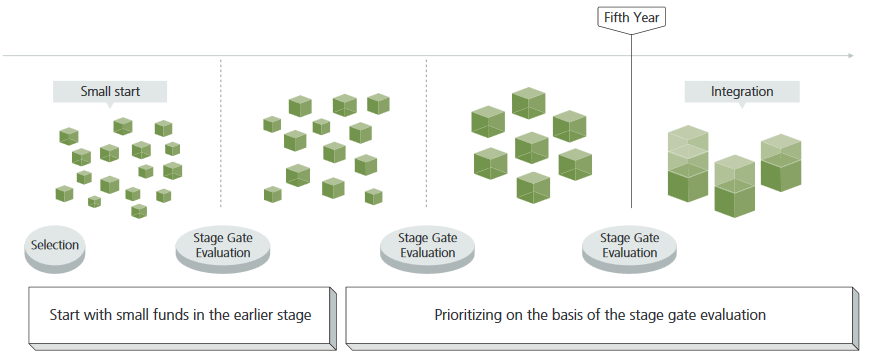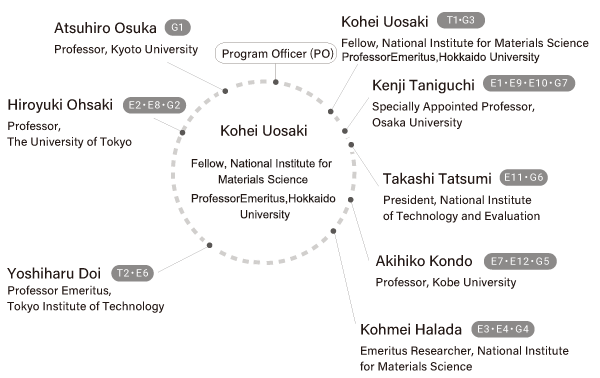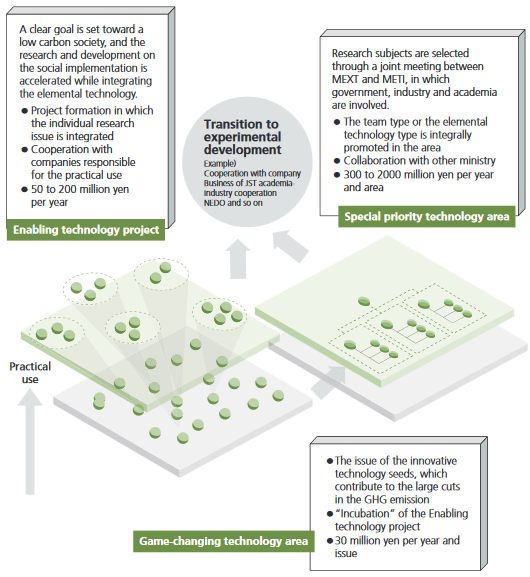ALCA Outline
The opportunity for technological development in environmental energy becoming ripe again
The emission of CO2 actually accounts for the largest percentage among greenhouse gases (GHG) as a cause of global warming issues. Today, through reducing it, realizing a low carbon society has become a global challenge. In the context of such an international trend, the Japanese government has taken an approach to reduce GHG emission, and the Advanced Low Carbon Technology Research and Development Program (ALCA) was launched in 2010 as a research program toward developing a low carbon technology for the reduction of GHG emission.
In the Paris Agreement, adopted in December 2015 in the 21st session of the Conference of the Parties (COP21) of the United Nations Framework Convention on Climate Change (UNFCCC), “holding the increase in the global average temperature within 2°C from pre-industrial levels and to pursue efforts to limit the temperature increase to 1.5°C from pre-industrial levels” has been requested. Specifically, each party is requested to submit its reduction target for after 2020 to the United Nations.
The Japanese government has formally decided a goal, which promised that “GHG will be reduced by 26% (compared with fiscal 2013) in fiscal 2030” in July 2015, prior to holding the COP21. The government decided that the achievement of such a goal should be aspired by innovative energy-saving technology development and also by largely reducing the ratio of the thermal power generation and by increasing the ratios of the renewable energy and nuclear power generation, from the current power supply configuration.
As mentioned above, the tide of enhancing to develop the environmental and energy-related technology has risen globally. It can be said that ALCA, which aims at creating a future low carbon society with game changing technology, is really a research program at the forefront of such a global trend.
Low carbon society by “mitigation option”
There are basically two approaches to solve the global warming issues: the “adaptation option” and “mitigation option”. The former is to reduce the global warming effect by adjusting a paradigm for nature and society. In contrast, the latter is to suppress the GHG emission themselves, which is greatly expected by the contribution of science and technology.
ALCA has every intention of building a low carbon society, curbing the emission of CO2 through energy generation, energy storage, carbon neutral and energy saving, though we can find scientific and technological options in various R&D areas.
Scope of ALCA
It is expected that the scientific and technological outcomes of ALCA will be implemented in the future society by conveying them to the research and development phase which is close to practical use. Therefore, it is necessary for research subjects in ALCA to satisfy the following three requirements.
- 1. There is an air of expectancy among the industry.
- 2. Sufficient effort has not been made yet in the industry.
- 3. It is expected that academia will deal with the problems in the future.
Creation of “game changing technology”
In order to realize a low carbon society, we must look to the creation of game changing technology, which greatly changes the paradigm of science and technology, to break through the existing fossil energy dependent society.
To do so, we are asked to identify research and development which should be addressed at present by back casting from the future low carbon society. In ALCA, which is a society needs pull type, it is encouraged to take inter-discipline efforts without being tripped up the existing mono-disciplines.
Selection and concentration by stage gate evaluation
While ALCA positively adopts game changing problems through peer review process to the proposals, a “stage gate evaluation” is strictly carried out during the research period for making a decision on continuing the research or not. The evaluation is made not only in light of the scientific merit, but also in the light of “potential contribution for a low carbon society”, which means the goal of ALCA.
With adopting, many PIs are adopted with relatively small funds (small start), and those which have passed through the stage gate evaluation will be prioritized. In the bottom up proposal type, the PIs who have passed the ALCA stage gates with the initial five fiscal years and which have further passed the stage gate focusing on the latter five fiscal years, will be driven forward in the ALCA research in the latter five fiscal years (enabling technology project) with the expanded research scale.
By the selection and concentration in such a stage gate evaluation, we intend to accelerate the research and development, focusing on the social implementation in 2030. We will adopt new ALCA problems to renew, proceeding with the concentration.

ALCA Tech. Areas
In ALCA we are promoting research and development in two domains: (a) the “top down proposal type technology area (special priority technology area)” focusing on a clear exit from R&D and (b) the “bottom up proposal type technology area” based on freedom of researchers. Each domain adopts problems depending on accumulation of technologies for them and prospect of their practical use, sharing game changing problems on a common basis.
Especially, in the special priority technology area, it is required that the individual elemental technology undertaken as a new science and technology is accumulated to productize (systemize). At the same time, the cooperation with the related programs and projects in other government agencies such as the Ministry of Economy, Trade and Industry (METI) is promoted and we are focusing on bridging the outcome for practical use.
On the other hand, in the bottom up proposal type, each research issue is of the bottom up type since it is based on the free idea from the researcher, and each research issue is also a problem-solving-type fundamental research towards “contribution to the future low carbon society”. Also in the adaptation and the stage gate evaluation, it is requested that the issue is “game changing” including “potential contribution to a low carbon society”.


| Top Down Proposal Technology Area | |
|---|---|
| T1 | Next Generation Batteries |
| T2 | White Biotechnology |
| Enabling Technology Project | |
| E1 | High-Quality and Large-Diameter GaN Wafer |
| E2 | Superconducting Electric Power Equipment using Liquid Hydrogen Cooling |
| E3 | New Heat Resistant Materials for Low CO2 Emission Type Next-Generation Thermal Electric Power Generation |
| E4 | Innovative Light-Weight Materials for the Forward Energy-Saving Society |
| E5 | Next-Generation Smart Community |
| E6 | Highly Efficient Production Process for Biomass-Based Chemicals and Polymers |
| E7 | Production of Effective Biomass Materials with Bioresource Technology |
| E8 | Development of Advanced Industrial Electricity Equipment for High-Efficiency Energy Equipment Systems |
| E9 | Waste-heat Recovery Technology |
| E10 | Photon Management and Optical Engineering |
| E11 | Development of Highly Efficient Carbon-Circulation Chemical System |
| E12 | Technology Development of High Efficient Bio Production by Innovative Cell Control Method and Breeding Method |
| Game-Changing Technology Area | |
| G1 | Solar Cell and Solar Energy Systems |
| G2 | Superconducting Systems |
| G3 | Electric Storage Devices |
| G4 | Ultra Heat-Resistant Materials and High Quality Recyclable Steel |
| G5 | Biotechnology |
| G6 | Innovative Energy-Saving and Energy-Producing Chemical Processes |
| G7 | Innovative Energy-Saving and Energy-Producing Systems and Devices |




